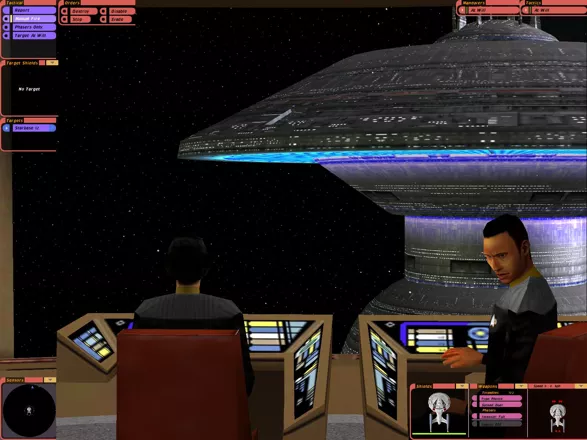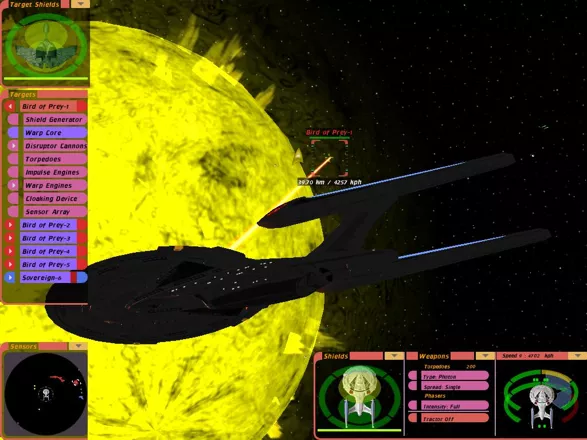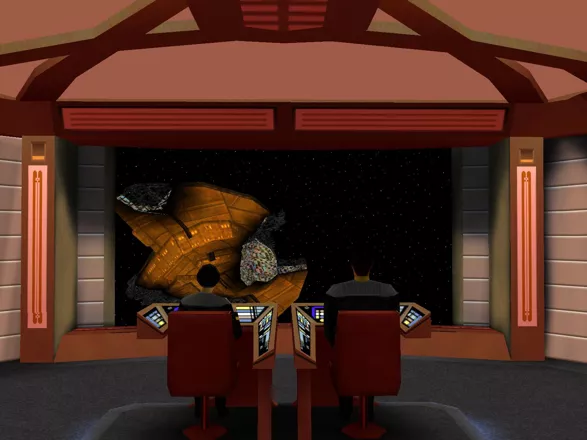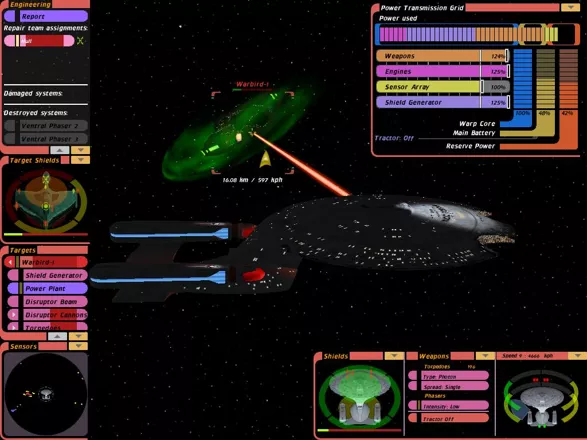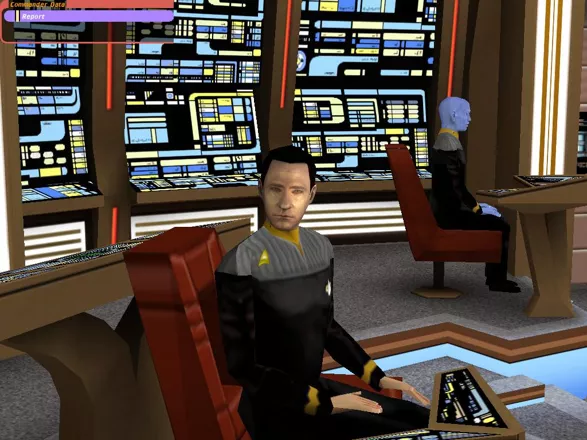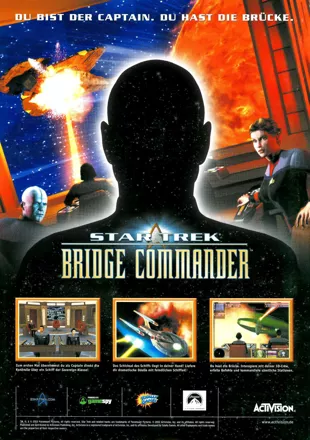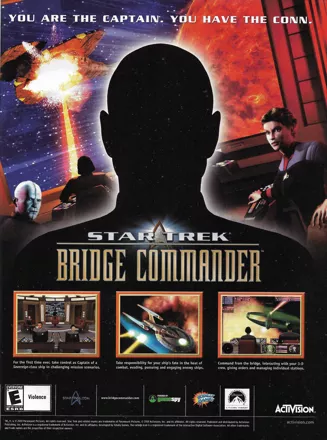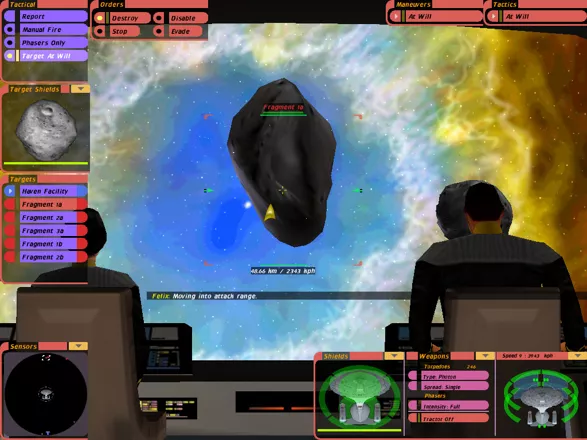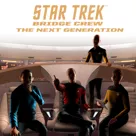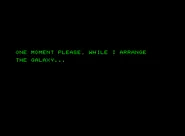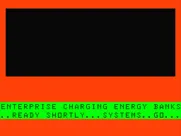Star Trek: Bridge Commander
Description official description
Star Trek: Bridge Commander puts the player in the role of the new captain of the starship USS Dauntless right after the previous captain perished in a sudden and mysterious explosion of the Vesuvi star which wiped out the nearer half of the planets in the system. Narrowly escaping the fallout, the ship is repaired, receives a new first officer and is tasked with investigating the background of the event throughout the region of space referred to as the Maelstrom, encountering other Federation, Klingon, Ferengi, Romulan, and Cardassian ships, as well as a new race known only as the Kessok.
The player can control the ship and its operations by speaking to the relevant personnel (e.g. hailing and moving the ship by talking to ensign LoMar, or managing the ship's power output and repairs by talking to chief engineer Brex), and can do so either from a first-person perspective from the captain's chair or by viewing the ship from the outside. The ship is almost entirely controllable through hotkeys, and its weapons can be fired manually via mouse controls. If the player's ship is joined by other friendly ships, they can be given simple commands.
The singleplayer campaign is split to 8 episodes, each with its own sub-missions, which form a larger storyline. Unlike many other licensed Star Trek games, combat is not the only focus of the game, as there are missions where exploration and assisting endangered colonies and ships is the main objective. A diplomatic decision late in the game affects the circumstances of the finale. Between missions, the player often moves to Starbase 12 for repairs, stocking on torpedoes, and occasionally to receive more delicate assignments.
Aside from the singleplayer campaign, the game has a so-called "Quick Battle" mode where the player can initiate battles using ships, stations and other objects which appeared in the main campaign, and the player can control any ship from the list. This game mode is also available in multiplayer.
Groups +
Screenshots
Promos
Videos
Add Trailer or Gameplay Video +1 point
See any errors or missing info for this game?
You can submit a correction, contribute trivia, add to a game group, add a related site or alternate title.
Credits (Windows version)
229 People (188 developers, 41 thanks) · View all
| Creative Director | |
| Project Lead | |
| Network & Interface Programming | |
| AI & Sound Programming, Physics & Simulation Programming | |
| 3D Graphics Programming | |
| Interface Programming | |
| Character & Bridge Programming, Save/Load Programming | |
| Game System Programming | |
| Lead Game Design | |
| Game Design, Mission Scripting, Story | |
| Art Lead, Environmental Art | |
| Bridge Sets | |
| Ship Art | |
| Character Animations | |
| Art Technician | |
| [ full credits ] | |
Reviews
Critics
Average score: 79% (based on 23 ratings)
Players
Average score: 3.9 out of 5 (based on 29 ratings with 8 reviews)
Great game, good to play even after all those years
The Good
Being able to control the ship by myself (which I actually prefer) or by computer, limiting the player's role to giving orders
The Star Trek feel
One can modify the game easily, there are plenty of mods and total conversions on-line
Being able to choose exactly where to hit the enemy - you can choose which subsystems of enemy vessel to shoot, or let the computer do it for you
Creating great space battles consisting of many ships on both sides
The Bad
Too linear plot in the campaign mode
When trying to pass another ship very close usually both ships explode although you can see there's plenty of space between them
Not being able to command a fleet or at least set up some tactics with allied ships
The Bottom Line
It's like Sea Dogs in the Star Trek Universe - nothing special, but still you can play it for months without being bored with it! If you ever wanted to feel like a starship captain - certainly it's a must have.
Windows · by Yesus (1) · 2009
Good Presentation, Flawed Game Play
The Good
The story is intriguing and well-written; a worthy bit of Star Trek fiction. You are cast in the role of first officer on the U.S.S. Dauntless, a Galaxy class starship investigating some anomalous solar activity in the Vesuvi system. While in the system, the ship's captain takes a shuttle to rendez-vous with a Federation terraforming outpost. As the shuttle approaches the outpost, the core of the Vesuvi system's star suddenly and inexplicably destabilizes. The captain orders you to get the ship out of danger, just before his shuttle is engulfed in a solar explosion. Hence the reason for your sudden promotion to captain.
As the Dauntless leaves the system, the science officer notices a strange object warping out of the system but he is unable to identify it. Suspicions abound that the Cardassians have something to do with this mysterious turn of events. Now in command of the Dauntless, you are ordered by Starfleet Command on a series of investigative missions aimed at discovering what happened in the Vesuvi system. The various missions serve to unfold the plot and the entire thing remains intriguing throughout.
The interface is extremely well designed in my opinion. Next Generation style LCARS panels are overlayed over a first-person 3D view of the bridge. In contrast with earlier Star Trek based simulations, you don't jump around between different control panels here. You never lose sight of your bridge and crew. The LCARS panels are there when you need them and move quickly out of your way when you don't. This interface is the most successful that I've seen so far in terms of making you feel like you're in the captain's chair overseeing the bridge and crew rather than jumping around from station to station micro-managing everything.
The graphics, in my opinion, are attractive overall. Bridge layouts are accurate, if simplified. Starship exteriors are nicely modeled. Light sourcing and specular highlights are used to good effect. There is a nice glow effect for lit windows, phaser beams and warp nacells and shields shimmer semi-translucently when absorbing hits.
There was an interesting design decision regarding the faces of the characters. Bitmapped character faces are pasted onto the heads of the character models. The mouths are animated when characters speak but, other than this, there is little facial animation. Eyes don't blink and expressions remain neutral. The result is characters that are instantly recognizable (Picard looks like Picard and Data looks like Data) but there is no real lip synching and character faces seem bland and expressionless, almost like everybody is wearing some kind of mask. The features also tend to look somewhat angular at times. This is something that I, personally, can live with, especially remembering that this game was released in 2002, when graphical hardware was not as advanced as it is now.
Sound is also nicely rendered. Phasers and torpedoes sound as they do in the television shows and movies. The voices of Captain Jean-Luc Picard and Lt. Commander Data are provided by Patrick Steward and Brent Spiner respectively. Voice acting for other characters (not seen on TV or in the movies) is likewise competent and believable. The musical soundtrack is typical for a Star Trek feature, grand and orchestral with a more dramatic cadence during battle engagements.
The Bad
Some of the missions are designed to be ridiculously hard, pitting your ship alone against hoards of enemy attackers with little or no support from Starfleet. What's worse, the penalty for getting out of some of these scenarios alive yet failing your primary objective is an unreasonably harsh dressing down by the Starfleet admiralty who, in my opinion, should really be impressed that you even managed to save your ship and crew, never mind knock out that enemy sensor array. Likewise you can successfully complete mission after mission, being lauded and praised by your superiors after each victory, only to be dismissed as an incompetent fool when you finally do fail. I guess it's true what they say; people really do remember your last mistake. One wonders, at times, whether one hasn't been unwittingly drafted into the service of the Imperial Klingon Fleet. Total and unqualified success, death or dishonour! Those are your options.
The mission structure suffers from the same weakness seen in Larry Holland's Star Wars games; namely, they are linear and heavily scripted and some are designed such that success depends on performing certain actions in a certain sequence or at a certain time. Doing anything else inevitably results in failure, and this makes several of the missions feel more like puzzles to be solved rather than tactical situations to be evaluated. It's no coincidence that failed missions are more successful the second or third time around, once you have the benefit of foreknowledge of what's going to happen.
I've read some other reviews of this game which complain about the inability to skip the cut scenes. I'd like to clarify this issue by pointing out that, although the cut scenes can't be skipped entirely, it is possible to skip to the next line of dialog by pressing the backspace key. Do this shortly after each line of dialog begins and it is possible to "skip forward" through all cut scenes quite quickly. Still, I do agree that it would have been nice if there had been a key to skip directly to the end of a cut scene or, better yet, a config setting allowing cut scenes to be turned off, or at least to be played only the first time through. This could have been handled better, but it's not as bad as some would have us believe.
The characters seem to blindly follow their scripts at times without any regard for what actually happens in the game. For example, at the start of one mission, my first officer recommended that we should return to the starbase for repair and resupply, even though:
a) We were already at the starbase b) They had just told us that they could only re-supply but not repair us. c) We had just finished docking and our supplies had been replenished.
Similarly, characters sometimes react to occurrences without considering the full situation. For example, in the heat of one particular space battle, my weapons officer targeted an enemy ship with photon torpedoes. The torpedoes failed to lock properly and missed their target, unfortunately hitting a friendly starbase that was beyond the target. My first officer reacted by promptly relieving me of command for firing on a friendly, apparently oblivious to the fact that I had never given any command to attack the starbase nor had I personally fired the errant torpedoes, never mind that the whole thing was obviously an unfortunate mishap. I might have understood had she decided to relieve the weapons officer for incompetence, I suppose.
Engagements between starships can last quite some time. It takes a while to destroy or disable a starship, unless the combatants are woefully mismatched. Your weapons officer will normally make intelligent decisions such that, with only a few exceptions, you can usually allow him to select his own targets and systems and such. This is as it should be. It does mean, however, that you can spend much of your time during battles, especially prolonged engagements involving multiple starships from various sides, simply watching the battle unfold. You might occasionally order your chief engineer to channel more power to the shields or the weapons or whatever system seems most important at the time but, other than this, you need do very little. This can make missions seem rather dull to some. On the other hand, you can manually take control of the ship and do all the fighting yourself, but this seems less in keeping with the Star Trek mythos, and you'll usually do no better than your weapons officer would have, in any case.
One graphical effect that bothered me more than the weird, angular faces of the characters was the fact that starships insist on belching smoke when damaged. Smoke in the vacuum of space? Whose idea was that? Fire, yes. Sparks, of course. But smoke? Methinks Larry Holland must have cannibalized his Secret Weapons of the Luftwaffe engine when building this game and forgotten to kill the smoke effects.
The graphics engine also attempts to show exposed decks beneath punctured hulls on severely damaged vessels, but this doesn't quite work for me either. Somehow, the effect looks too much like a 2D bitmap. It was done much better in Interplay's Star Trek: Klingon Academy.
The Bottom Line
Star Trek: Bridge Commander does have its flaws but, overall, I enjoyed it. It's strength is in its presentation. Its weakness, unfortunately, is in the actual gameplay. Still, I think it fair to say that it comes as close to simulating the experience of commanding a Federation starship as any Star Trek game has to date, even if it doesn't entirely hit the mark.
Windows · by Halmanator (598) · 2005
One of the better Star Trek games released - but not for gamers that get easily bored
The Good
Almost everything - besides, it's not every day you get to sit in the captains chair of Star Trek ships.
I'll go into minor detail: Excellent atmosphere which really re-lives the famous Star Trek feeling from the series and some of the movies, great plot, great voice-acting, good controls, good strategic combat, and overall a well accomplished game.
The Bad
Being a gamer that values freedom, I really think they could have out even more into this Star Trek title - I mean, we got the bridge of a starship; and everything in the game is almost just right to make the new Elite, or 3D StarFlight - imagine if we could go to other systems to trade and explore freely in this Star Trek universe...
But this is not the case; the player is only led trough a certain chain of missions, without any real chance of freedom - sure, there is a skirmish-mode available, but it really don't give much more freedom either - you just get to blow up different ships from various species.
There's also the thing that this is not a game for most action gamers; there's long conversations, and often long periods of waiting in this game, and quite often you find yourself going ahead of the game itself.
For me, this is not a problem, as I like such things, but for others, it might be quite annoying at places.
The Bottom Line
Overall though, Star Trek: BC is a good game with lots of sadly unexplored potential; it is not everyones cup of tea, but if you like Star Trek, or better yet, if you like sci-fi (like myself), this is a game I recommend - just don't expect too much; it IS a good game, but it could have been much better (but then again, its a commercial space-game).
So, I give it one thumb up - for a good game with good plot and fairly well accomplished.
Windows · by Stargazer (99) · 2003
Trivia
If you click on Brex several times in a row, he will say some amusing things.
Analytics
Upgrade to MobyPro to view research rankings!
Related Sites +
-
Bridge Commander Universe
Page with game info, forums and various mods. -
Star Trek: Bridge Commander
An anthology of mods for the game -
Star Trek: Bridge Commander: Kobayashi Maru
Kobayashi Maru is an enhancement to Star Trek: Bridge Commander, it brings many advanced features to both quick battle and multiplayer to deliver to you a new and exciting experience.
Identifiers +
Contribute
Are you familiar with this game? Help document and preserve this entry in video game history! If your contribution is approved, you will earn points and be credited as a contributor.
Contributors to this Entry
Game added by Kartanym.
Additional contributors: Apogee IV, Erik Novales, Independent, Plok.
Game added March 8, 2002. Last modified October 11, 2023.

